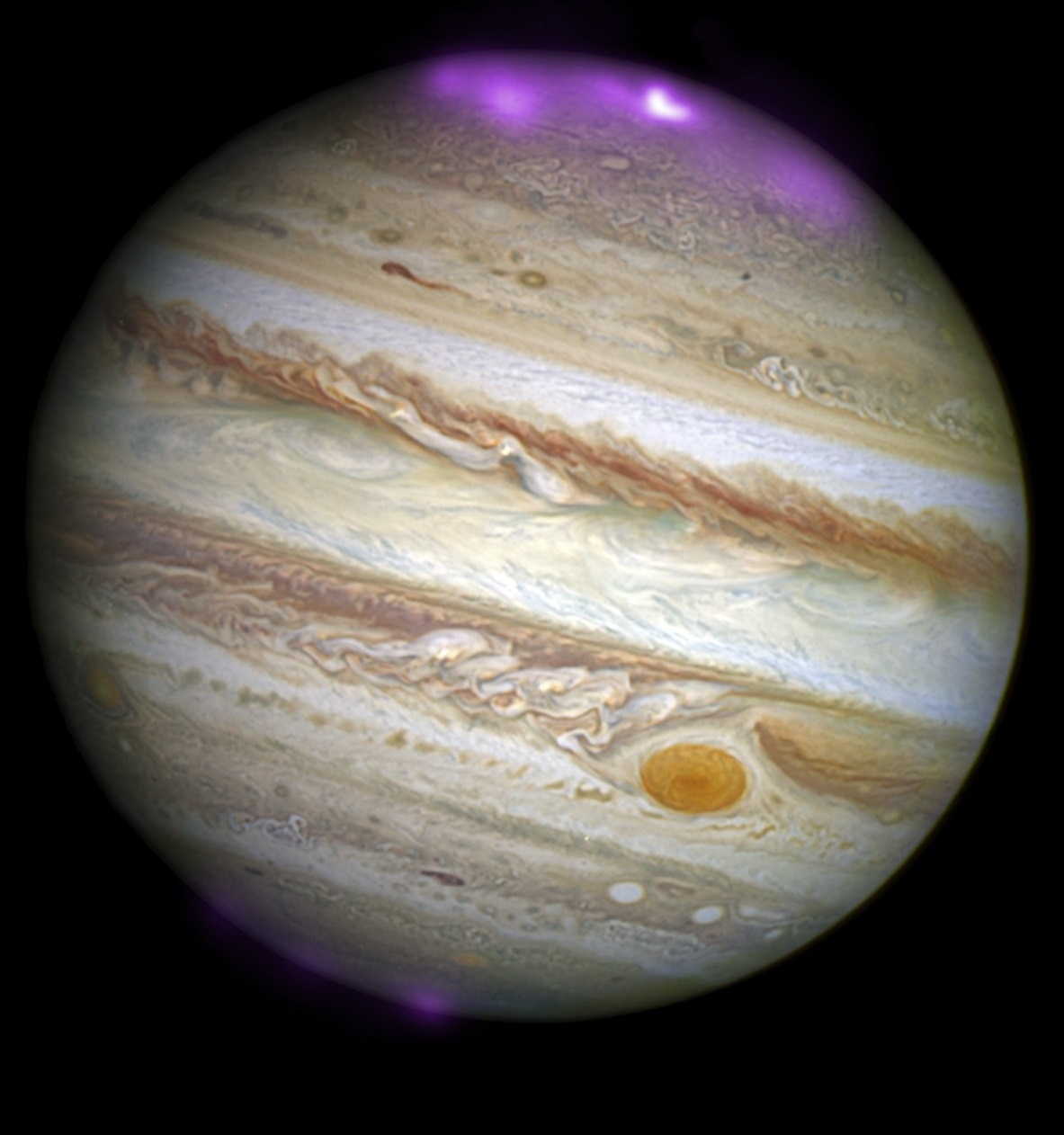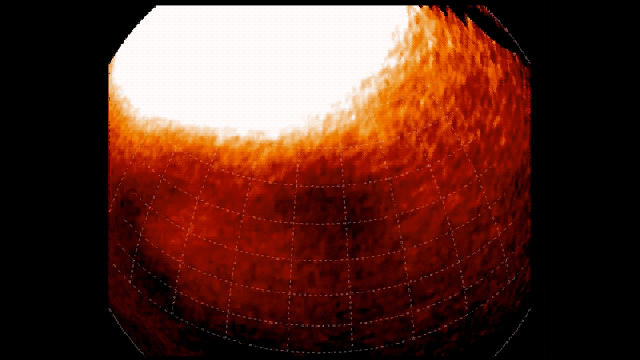Using the Very Large Telescope array, an international team of astronomers has discovered a previously undetected cold spot on Jupiter. Measuring 14,000km wide and 12,000km across, the mysterious spot is bigger than the Earth itself. Intriguingly, the weather anomaly is likely being generated by Jupiter’s spectacular Northern Lights.
A computerised view of the Great Cold Spot as it would appear directly above Jupiter at a distance of 35,000km above the planet. (Image: NASA/IRTF Telescope/University of Leicester
New research led by University of Leicester astronomers and published in Geophysical Research Letters shows that Jovian weather is even more complex than we thought, and includes a localised dark spot near Jupiter’s north pole that’s probably being generated by the gas giant’s polar aurorae. The anomaly was only detected recently, but by analysing archived atmospheric data, the astronomers were able to show that it has been present in the upper atmosphere for the past 15 years. It’s likely quite ancient — a feature as old as the gas giant’s aurorae itself. The spot’s shape changes dramatically over the course of days to weeks, but as a planetary weather feature, it’s persistent.
Despite Jupiter’s location in the outer Solar System, the gas giant is capable of generating a lot of heat. In its high-altitude thermosphere, temperatures can range between 700 degrees Kelvin (426C) and 1000 degrees Kelvin (726C). But at the newly-discovered Great Cold Spot, temperatures are about 200 degrees Kelvin cooler than the surrounding atmosphere (73C).
The astronomers, led by Tom Stallard, an associate professor in planetary astronomy at the University of Leicester in the United Kingdom, detected this feature by analysing recent observations made by the ESO-VLT telescope and its state-of-the-art CRIRES instrument. This offered an unprecedented level of detail when analysing Jupiter’s sub-auroral atmosphere. The discovery of a noticeable dip in the light output of ions in the planet’s northern regions could have been passed off as weird anomaly, but Stallard’s team decided to investigate further. It wasn’t until the researchers went back and added up many individual observations made over the past 15 years that the Great Cold Spot appeared in the data as a consistent feature.

Unlike Earth’s aurorae, Jupiter’s Northern Lights generate a considerable amount of heat. Our planet’s atmosphere receives charged particles from the Sun, but Jupiter gets most of its particles from the volcanic moon of Io.
“This means that the aurora of Jupiter have a much larger source of these particles — they are, as a result, much brighter than the aurora of Earth, and much less variable,” Stallard told Gizmodo. “So the aurora are actually a visual queue of a current that flows from the surrounding space environment into the atmosphere, forming an electric circuit. The upper atmosphere of Jupiter acts like a resistor in any electrical circuit, or the filament in a light bulb — the neutral molecules act to stop ions flowing, so as the ions move through the atmosphere, the current generates a lot of heat.”
By measuring the glow of these ions, the researchers were able to see that a peculiar spot near Jupiter’s north pole is much colder than the surrounding atmosphere.
“We speculate that this is a weather feature caused by the neutral atmosphere moving differently in the auroral region and at lower latitudes,” explained Stallard. “In both Jupiter and Earth’s lower atmosphere, when two regions of the atmosphere flow past each other, it can produce a vortex, which then causes localised changes in conditions. This may be creating a localised cool region in the upper atmosphere.”
Interestingly, Stallard says there is some evidence that a similar feature exists on Earth, but because the aurora on Earth are so much more variable, this vortex appears and disappears intermittently over the course of only a few hours.

The Great Cold Spot changes dramatically in shape and size on different days. (University of Leicester)
The authors saw the same cold spot in recent observations, and during observations made between 1995 to 2000. The existing 15-year data set shows that the Great Cold Spot gets quite distorted at times, and sometimes disappears almost completely. This suggests the spot is quite different from the Great Red Spot, which changes over a timescale of years.
“Instead, the Great Cold Spot is re-generated again and again in the same approximate place, similar to the way you often feel the same gusts of wind between two tall buildings — the aurora is blowing with the same general flows, so the feature reappears in a similar place,” Stallard told Gizmodo. “This means it is likely that the spot has been re-appearing for as long as Jupiter’s aurora has had its current shape. Looking at how quickly Earth’s magnetic field changes, it is likely the cold spot has existed for thousands of years, perhaps much longer.”
The discovery of the Great Cold Spot came as a complete surprise, but the researchers have good reason to believe other similar features might exist in Jupiter’s atmosphere. With the Juno spacecraft currently in orbit around Jupiter, and with its instruments collecting valuable atmospheric data, the researchers now have an opportunity to find more of these mysterious weather features. No doubt, as this new study shows, there’s still lots to learn about our Solar System’s largest planet.
